本文题解 leetcode 如下:
- 121 Best Time to Buy and Sell Stock
- 122 Best Time to Buy and Sell Stock II
- 123 Best Time to Buy and Sell Stock III
- 188 Best Time to Buy and Sell Stock IV
- 309 Best Time to Buy and Sell Stock with Cooldown
- 714 Best Time to Buy and Sell Stock with Transaction Fee
其实上述题目背景基本是一致的:给定一个非负整数数组,这个数组表示一段时间内某个股票的价格变动情况,我们需要求解交易可获得的最大收益,注意不能同时参与多笔交易(必须在再次购买股票前出售掉之前的股票),但上述题目对交易的限制条件是不同的:
- 121 : 至多进行一次交易
- 122 : 对交易次数不做限制
- 123 : 至多进行两次交易
- 188 : 至多进行 k 次交易
- 309 : 对交易次数不做限制,但在卖股票当天的后一天无法买入股票(技能冷却一天)
- 714 : 对交易次数不做限制,但每次卖股票的当天将收取值为 fee 的交易手续费
对于不同的限制条件,将导致不同的解题策略
121 : 至多进行一次交易
题目链接 : leetcode.com/problems/be…
Example 1:
Input: [7,1,5,3,6,4]
Output: 5
Explanation: Buy on day 2 (price = 1) and sell on day 5 (price = 6), profit = 6-1 = 5.
Not 7-1 = 6, as selling price needs to be larger than buying price.
Example 2:
Input: [7,6,4,3,1]
Output: 0
Explanation: In this case, no transaction is done, i.e. max profit = 0.
至多进行一次交易的情况是最直观的,要想获得最大利润,显然就是要在数组中要找两个点,前者处于低谷,后者处于高峰,且两者的差值最大(低价买高价卖)
如下图所示,以折线图的角度看,从第 1 天买入股票,到第 6 天卖股票,得到的收益是最大的
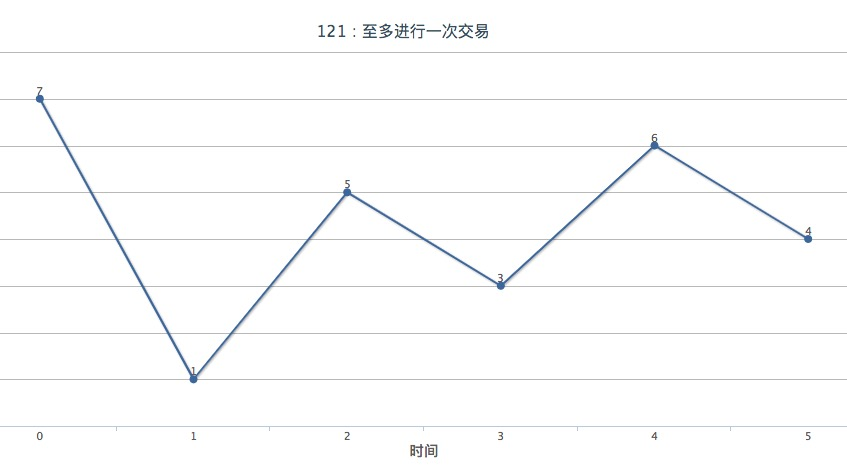
当然如果是股票狂跌的情况,自然是找不到这样的两个点的
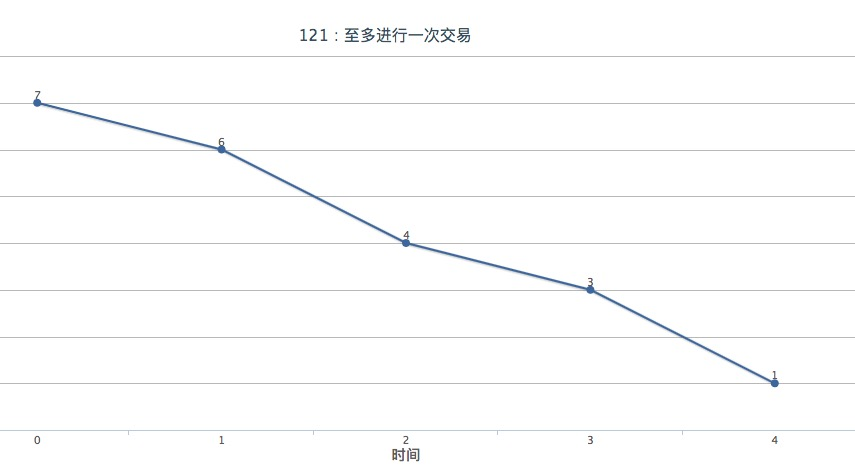
假设 i 为交易天数的迭代变量,此时我们可以定义两个变量:
- minPrice : 从第 0 天到第 i 天股票出现的最低价格
- result : 从第 0 天到第 i 天卖掉价格为 minPrice 的股票所产生的最大利润
根据上述定义,在未进行交易的初始情况下,可设 minPrice 为无穷大,result 为 0
const (
INT_MX = 1 << 31
)
// 低价买,高价卖
func maxProfit(prices []int) int {
result, minPrice := 0, INT_MX
for _, price := range prices {
minPrice = minV(minPrice, price)
result = maxV(result, price-minPrice)
}
return result
}
func minV(a, b int) int {
if a < b {
return a
}
return b
}
func maxV(a, b int) int {
if a > b {
return a
}
return b
}
122 : 对交易次数不做限制
题目链接 : leetcode.com/problems/be…
Example 1:
Input: [7,1,5,3,6,4]
Output: 7
Explanation: Buy on day 2 (price = 1) and sell on day 3 (price = 5), profit = 5-1 = 4.
Then buy on day 4 (price = 3) and sell on day 5 (price = 6), profit = 6-3 = 3.
Example 2:
Input: [1,2,3,4,5]
Output: 4
Explanation: Buy on day 1 (price = 1) and sell on day 5 (price = 5), profit = 5-1 = 4.
Note that you cannot buy on day 1, buy on day 2 and sell them later, as you are
engaging multiple transactions at the same time. You must sell before buying again.
Example 3:
Input: [7,6,4,3,1]
Output: 0
Explanation: In this case, no transaction is done, i.e. max profit = 0.
本题对交易次数不做限制,如下图所示,如果仅允许交易一次,那么我们选的交易点是在 a 点买入,在 d 点卖出,但现在我们并不限制任何购买次数,因此交易策略就很简单了:每逢低谷(a 和 c 点)买股票,每逢高峰(b 和 d 点)卖股票
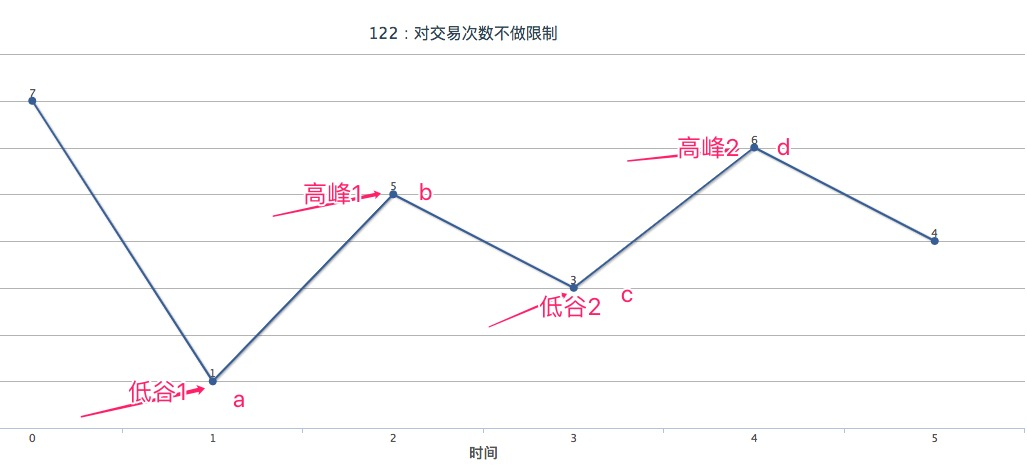
从图中可以轻易看到:
b-a+d-c = b+(d-a)-c > d-a
说白了,如果一个很大的上坡路可以分解为若干个上坡路和下坡路,那么这些上坡路的海拔差之和肯定大于等于总体上坡路的海拔差,因为有了低谷对海拔差之和的贡献
// 低价买入,高价卖出
// 找出所有的 peak 和 valley 即可
func maxProfit(prices []int) int {
n := len(prices)
if n <= 1 {
return 0
}
index, peak, valley, result := 0, prices[0], prices[0], 0
for index < n-1 {
// 找到第一个 prices[index] 小于 prices[index+1]
for index < n-1 && prices[index] >= prices[index+1] {
index++
}
valley = prices[index]
// 找到第一个 prices[index] 大于 prices[index+1]
for index < n-1 && prices[index] <= prices[index+1] {
index++
}
peak = prices[index]
result += (peak - valley)
}
return result
}
其实此题没必要如此大费周章,因为不限制交易次数,所以从直觉上说,只要有得赚(第 i 天的股价大于第 i-1 天的股价),就直接买第 i-1 天的股票,卖第 i 天的股票
func maxProfit(prices []int) int {
n := len(prices)
result := 0
for i := 1; i < n; i++ {
if prices[i] > prices[i-1] {
result += prices[i] - prices[i-1]
}
}
return result
}
上述解法相对更直观
123 : 至多进行两次交易
题目链接 : leetcode.com/problems/be…
Example 1:
Input: [3,3,5,0,0,3,1,4]
Output: 6
Explanation: Buy on day 4 (price = 0) and sell on day 6 (price = 3), profit = 3-0 = 3.
Then buy on day 7 (price = 1) and sell on day 8 (price = 4), profit = 4-1 = 3.
Example 2:
Input: [1,2,3,4,5]
Output: 4
Explanation: Buy on day 1 (price = 1) and sell on day 5 (price = 5), profit = 5-1 = 4.
Note that you cannot buy on day 1, buy on day 2 and sell them later, as you are
engaging multiple transactions at the same time. You must sell before buying again.
Example 3:
Input: [7,6,4,3,1]
Output: 0
Explanation: In this case, no transaction is done, i.e. max profit = 0.
此题实际上相当于 121 的增强版
在 121 中,限制条件是至多交易 1 次,所以要找最低谷和最高峰做差,而本题其实是类似的,只是至多交易 2 次
回顾 121 的状态方程,我们定义了两个状态变量:
- minPrice : 从第 0 天到第 i 天股票出现的最低价格
- result : 从第 0 天到第 i 天卖掉价格为 minPrice 的股票所产生的最大利润
minPrice = minV(minPrice, price)
result = maxV(result, price-minPrice)
123 这道题也可以用 121 的方式来做,只不过此时需要定义 4 个变量:
- firstHold : 第一次持有股票的最大收益
- firstCash : 第一次卖股票的最大收益
- secondHold : 第二次持有股票的最大收益
- seconCash : 第二次卖股票的最大收益
状态转移方程如下:
// 第一次持有股票得到的最大收益
// 如果 prices[i] 刚好是最低谷那 firstHold 就一直不变了
// 跟 121 的 minPrice 其实是一个概念,只是这里用负值表示
firstHold = maxV(firstHold, 0-prices[i])
// 第一次卖掉股票得到的最大收益(可以在同一天买卖)
firstCash = maxV(firstCash, firstHold+prices[i])
// 第二次购买股票,包含第一次卖掉股票的最大收益,这里的 firstCash 很关键
secondHold = maxV(secondHold, firstCash-prices[i])
// 第二次卖掉股票得到的最大收益
secondCash = maxV(secondCash, secondHold+prices[i])
以 example 1 为例 [3,3,5,0,0,3,1,4]
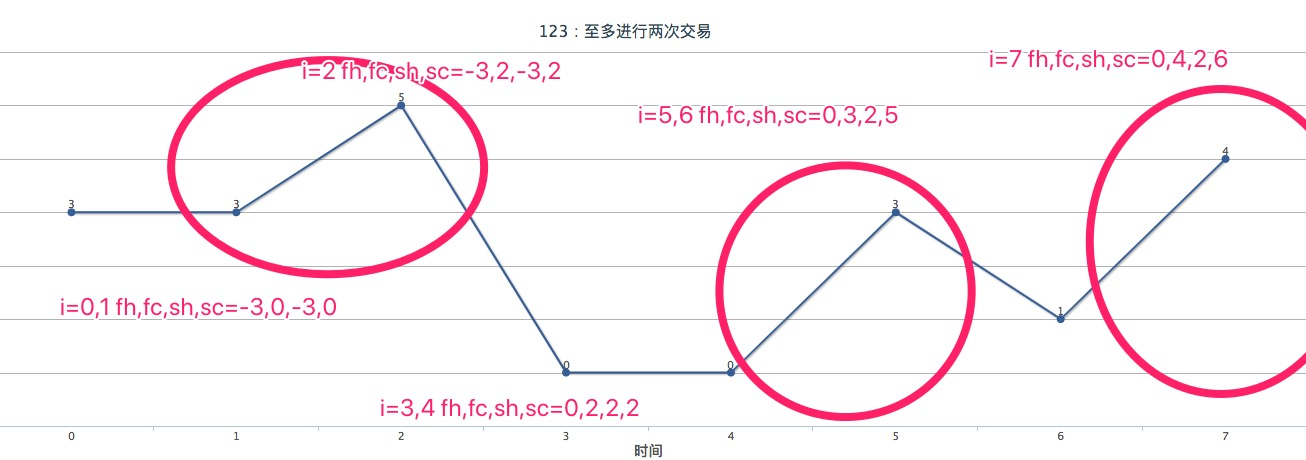
其实可以看到,第二次交易是依赖于第一次交易的,而第一次交易的策略刚好与 121 至多交易 1 次的策略一致
188 : 至多进行 k 次交易
题目链接 : leetcode.com/problems/be…
Example 1:
Input: [2,4,1], k = 2
Output: 2
Explanation: Buy on day 1 (price = 2) and sell on day 2 (price = 4), profit = 4-2 = 2.
Example 2:
Input: [3,2,6,5,0,3], k = 2
Output: 7
Explanation: Buy on day 2 (price = 2) and sell on day 3 (price = 6), profit = 6-2 = 4.
Then buy on day 5 (price = 0) and sell on day 6 (price = 3), profit = 3-0 = 3.
这题就没办法单纯画图来描述了,但如果懂得 123 题的逻辑,那么这题也就简单了,类比就完事了
在 123 题里我们的状态转移方程如下:
firstHold = maxV(firstHold, 0-prices[i])
firstCash = maxV(firstCash, firstHold+prices[i])
secondHold = maxV(secondHold, firstCash-prices[i])
secondCash = maxV(secondCash, secondHold+prices[i])
而此题其实同理,比如如果 k = 3,有:
thirdHold = maxV(thirdHold, secondCash-prices[i])
thirdCash = maxV(thirdCash, thirdHold+prices[i])
所以实际上我们可以定义 hold 数组和 cash 数组来表示
hold[k] = maxV(hold[k], cash[k-1]-price)
cash[k] = maxV(cash[k], hold[k]+price)
另外如果 k 的值大于或等于给定数组的一半,也就是 k >= len(array)/2 ,那么此问题就转换为 122,也就是交易任意次数了
具体代码如下所示:
const (
INT_MX = 1 << 31
)
func maxV(a, b int) int {
if a > b {
return a
}
return b
}
func maxProfit(k int, prices []int) int {
n, result := len(prices), 0
if k >= n/2 {
for i := 1; i < n; i++ {
if prices[i] > prices[i-1] {
result += (prices[i] - prices[i-1])
}
}
} else {
hold, cash := make([]int, k+1), make([]int, k+1)
for i := 0; i <= k; i++ {
hold[i], cash[i] = -INT_MX, 0
}
for _, price := range prices {
for i := 1; i <= k; i++ {
hold[i] = maxV(hold[i], cash[i-1]-price)
cash[i] = maxV(cash[i], hold[i]+price)
}
}
result = cash[k]
}
return result
}
309 : 对交易次数不做限制,但在卖股票当天的后一天无法买入股票(技能冷却一天)
题目链接 : leetcode.com/problems/be…
Example:
Input: [1,2,3,0,2]
Output: 3
Explanation: transactions = [buy, sell, cooldown, buy, sell]
Example 的交易策略如下图所示:
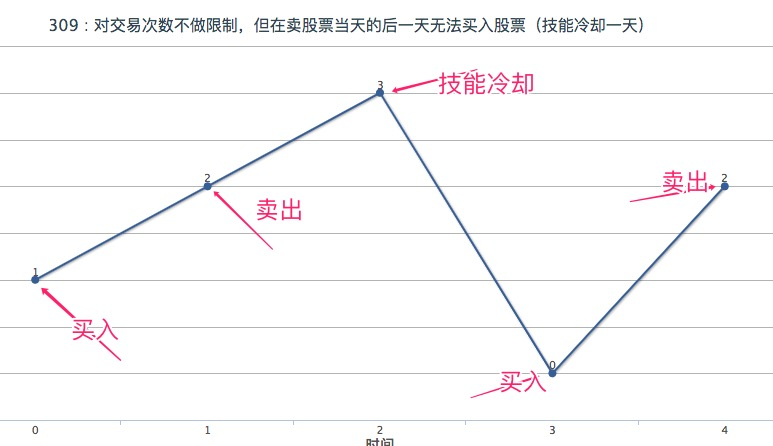
在此题中我们将定义 6 个状态变量(实际上是 3 个,另外 3 个的区别只是天数不同):
- a0 : 第 i 天没有持有股票的最佳收益
- a1 : 第 i 天持有股票后的最佳收益
- a2 : 第 i 天卖出股票后的最佳收益
- t0 : 第 i-1 天没有持有股票的最佳收益
- t1 : 第 i-1 天持有股票后的最佳收益
- t2 : 第 i-1 天卖出股票后的最佳收益
上述这么解释可能有点抽象,以状态图解释:
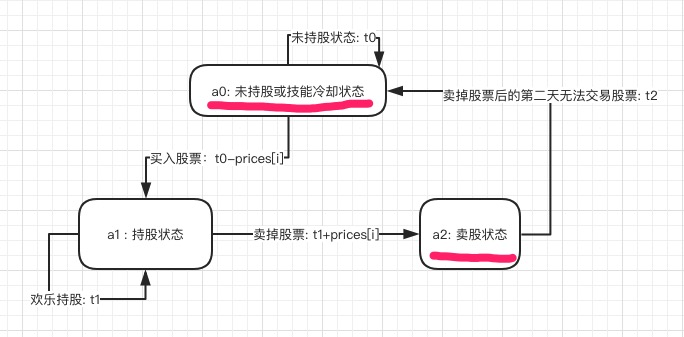
从上述状态图,我们可以写出状态转移方程:
a0 = maxV(t0, t2)
a1 = maxV(t1, t0-prices[i])
a2 = t1 + prices[i]
第 i 天的最佳收益由第 i-1 天的最佳收益决定,所以算是比较典型的动态规划问题(重叠子问题、最优子结构)
可以看到最后迭代的结果就是从 a0 和 a2 两者中选最大值,这里的 cooldown (技能冷却)体现在从 a2 到 a0 的状态转变中
初始化的情况,即 i=0 的时候,有:
// 第 0 天没有买股票
a0 = 0
// 第 0 天买股票
a1 = -prices[0]
// 第 0 天卖不了股票
a2 = 0
// t0、t1、t2 未定义
当 i > 0 时:
- 分别初始化 t0、t1、t2 为 a0、a1、a2,然后再利用 t0、t1、t2 计算新的 a0、a1、a2
- a0 : 第 i 天没有持有股票的最佳收益,那有两种情况,取其最大值
- 继续不买股票,所以为第 i-1 天没有持有股票的最佳收益 -> t0
- 处于冷却期,因为第 i-1 天卖掉股票后的最佳收益,使得第 i 天进行技能冷却 -> t2
- a1 : 第 i 天持有股票后的最佳收益,同样也有两种情况,取其最大值
- 欢乐持股,所以为第 i-1 天持有股票后的最佳收益 -> t1
- 买入股票(从未持股到持股) -> t0-prices[i]
- a2 : 第 i 天卖出股票后的最佳收益,根据定义只能有一种情况 -> t1+prices[i]
func maxV(a, b int) int {
if a > b {
return a
}
return b
}
// a0 : 代表没有买入股票的状态
// a1 : 代表买入后等待卖出的状态
// a2 : 代表从 a1 卖出股票的状态
func maxProfit(prices []int) int {
if len(prices) <= 1 {
return 0
}
a0, a1, a2 := 0, -prices[0], 0
var t0, t1, t2 int
for i := 1; i < len(prices); i++ {
t0, t1, t2 = a0, a1, a2
a0 = maxV(t0, t2)
a1 = maxV(t1, t0-prices[i])
a2 = t1 + prices[i]
}
return maxV(a0, a2)
}
714 : 对交易次数不做限制,但在每次卖股票的当天将收取值为 fee 的交易手续费
题目链接 : leetcode.com/problems/be…
Example 1:
Input: prices = [1, 3, 2, 8, 4, 9], fee = 2
Output: 8
Explanation: The maximum profit can be achieved by:
Buying at prices[0] = 1
Selling at prices[3] = 8
Buying at prices[4] = 4
Selling at prices[5] = 9
The total profit is ((8 - 1) - 2) + ((9 - 4) - 2) = 8.
此题与上一题类似,也属于动态规划问题,但定义的状态相对简单,因此也更好理解些:
- currentCash : 第 i 天未持有股票时所获得的最大收益
- currentHold : 第 i 天持有股票时所获得的最大收益
状态图如下:
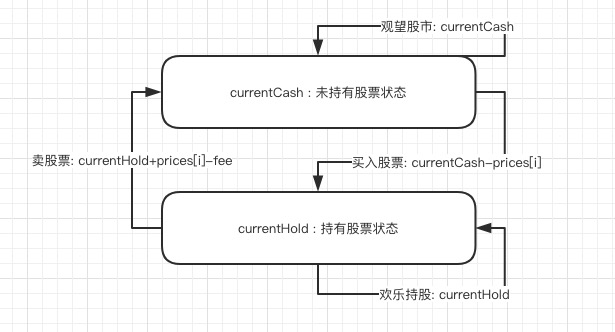
相应状态转移方程和代码如下:
// 买卖股票有两种状态,第 i 天结束后:
// 1. 未持有股票(观望股市,或者把先前持有股票卖了)
// 2. 持有股票(欢乐持股,或者买第 i 天的股票)
func maxProfit(prices []int, fee int) int {
// 初始化为第 0 天,有两种情况:不买第 0 天的股票;买第 0 天的股票
currentCash, currentHold := 0, -prices[0]
for i := 1; i < len(prices); i++ {
currentCash = maxV(currentCash, currentHold+prices[i]-fee)
// 为什么这里可以用已经计算过的第 i 天的 currentCash
// 去算 currentHold 呢?因为不限制购买次数
// 完全可以当天卖再当天买,不影响最后的计算结果的
currentHold = maxV(currentHold, currentCash-prices[i])
}
return currentCash
}